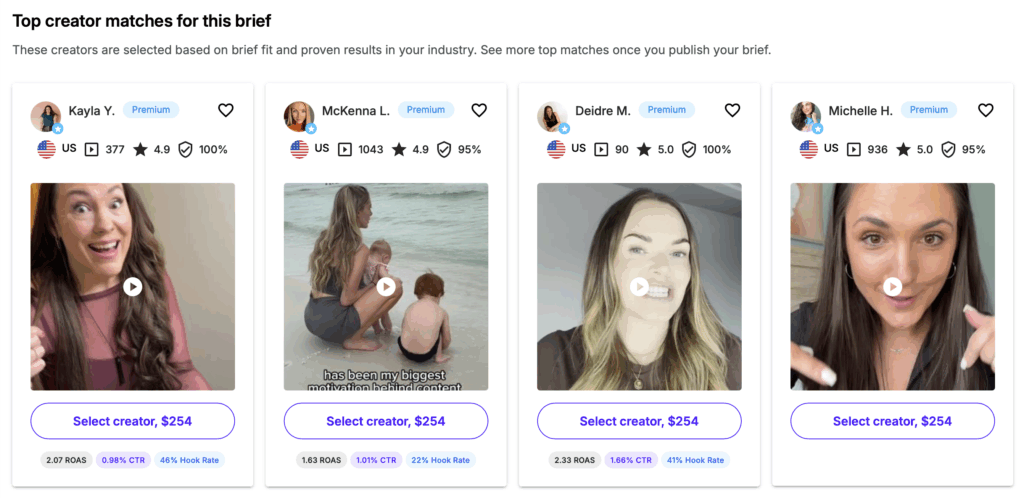9 Proven Ways To Increase ROAS For Paid Ads
After bouncing around tech start-ups and university literature programs, Joe has finally settled down as Billo’s Head of Content. Joe now spends his days writing ads about ads, teaching clients how to craft killer content, and combing through our web copy with a bold red Sharpie.

Short‑form video dominates attention on Meta and TikTok, but attention alone doesn’t pay the bills. ROAS is simple – ad revenue divided by ad cost – and it’s the clearest way to judge if creative, targeting, and landing pages are working together.
This playbook shows how to increase ROAS for paid ads with creator‑led video, smarter testing, and a tighter funnel from scroll to checkout.
TL;DR:
- Lead with a clear hook in the first three seconds.
- Design for sound‑off with captions and bold on‑screen text.
- Use UGC to cut costs and lift trust to increase ROAS for paid ads.
- Test placements, dayparting, and bidding before scaling budgets.
- Build a weekly creative loop and fix the landing page leaks.
What Is ROAS And Why Does It Matter?
While everyone knows organic social media exposure contributes to branding and marketing efforts, it’s difficult to calculate what that return on investment is. With paid internet ads, however, you can calculate exactly what your return on ad spend (ROAS) is.
ROAS is simply the ad revenue divided by the cost of the ads. It’s an important metric because, at the end of the day, advertising is about sales, not just traffic or clicks.
If you aren’t happy with your current ROAS, there are ways to improve it from various angles. You’ll want to improve the quality with creative video ads while lowering your cost to make each video, optimizing your landing pages, and making sure your ad spend is competitive. Here are 9 proven ways to increase ROAS.
#1 Use UGC for paid ads to increase ROAS
Creator‑style content works because it feels like a referral, not an ad. In fact, around 79% of consumers say that user-generated videos have impacted their purchase decisions. Ads that feature everyday consumers provides a similar experience to viewers as receiving advice from a friend.
Lower lift per asset means you can test more angles, retire weak ones faster, and compound learnings toward scalable winners.
Best way to go forward is to lead with one clear promise in the first three seconds, then show the product in a real‑life use case. Keep cuts fast, put a human face and hands on screen, add captions and on‑screen benefits for sound‑off viewing, and close with a single, obvious CTA.

#2. Win the First 3 Seconds With a Clear Hook
Whether it is a UGC or a scripted ad, open with the clearest benefit your viewer cares about and say it fast. Make the promise concrete so it earns the next few seconds of attention.
Grabbing the attention of people on social media is becoming tougher and tougher. There the right hook plays a major role here. Try different approaches to see what your audience prefers and then double down on that content. Here are some of the best performing UGC hooks at the moment.
Best way to start testing is to build three to five alternate hooks for the same concept and rotate quickly. Small angle shifts can change scroll behavior and increase ROAS.
#3 Design for Silent Autoplay With Captions
A lot of viewers are scrolling social media at public spaces or at work, thus it is best to assume they watch without sound. Use this knowledge to your advantage and make the message land visually. If the story only works with voice‑over, it won’t scale.
Write the script as on‑screen lines first, then layer VO if needed. Each line should deliver a benefit or proof, not filler. Moreover, test text color, placement, and pacing across a few variants. Small readability wins compound and help increase ROAS for paid ads.
Best practices are to use large, high‑contrast captions and keep them to one idea per frame. Sync text with clear visual beats so understanding doesn’t depend on audio.
#4 Choose a Human‑First Thumbnail That Stops the Scroll
A human face is bound to catch our attention, so select a frame with a well‑lit, smiling face looking toward the camera. Humans process faces quickly, and friendly eye contact earns a beat of attention.
Keep the composition clean with high contrast and minimal background noise. Avoid tiny text or clutter that shrinks to mush on small screens.
Best way to move forward is to test two or three frames from the same video and measure CTR. Surprising differences in micro‑expressions or lighting can decrease or increase ROAS.
#5 Fix the Landing Page to Capture Paid Clicks
Once you’ve captured your audience’s attention, the work is far from over. If your ads aren’t converting it might be less about the ad creative and more about the landing page. It would be a good idea to split test your landing pages to see what tweaks you can make for more sales.
Match the opening promise in your ad to the headline and hero on the page. Message consistency reduces bounce and preserves intent. It is best to keep the page fast and focused. Aim for lightweight images, compressed video, and a clear primary CTA above the fold.
One theory to test is using video on the landing page as well. You already know that consumers love video, why not include it on the landing page? Having some user-generated social proof right before they hit the buy button could be powerful.
#6 Test Placements and Dayparting to Find Winners
Play with placements and time of day to find the best slots. Start wide with multiple eligible placements, then read cost per result by slot. Patterns emerge fast when you compare CTR, completion, and ROAS across feeds, in‑stream, and other contexts.
Let performance steer consolidation rather than preference. Shift budget toward placements that consistently hit target CPA while maintaining stable ROAS. Layer dayparting once you see hourly or daily swings. Schedule delivery to the windows when your audience is most active and conversion‑ready.
It is also important to watch frequency and fatigue as you narrow. If costs climb, rotate new hooks or widen the schedule to reset performance and increase ROAS.
Document winners and losers in a weekly log. Re‑test retired placements quarterly because auctions and behaviors change.

#7 Review Your Ad Spend Before Scaling Budget
The good news is that social media ads are relatively inexpensive. The bad news is that not paying attention to your ad spend could result in lost revenue. Facebook for one offers several spending strategies. For example, you can pay for ads by impressions or by link clinks. It’s a good idea to split test your ads with different bidding strategies to see what works best for you.
You can also be aware of when your audience is likely to be online and schedule your ads to only run during this time. The ads can be optimized for where you place them, for example in the news feed or using “in-stream” ads. Kingsford Charcoal was able to increase ROAS by testing the best ad placement spots
#8 Tighten Targeting With First‑Party Insights
Build audiences from real customer behavior, not assumptions. Start broad enough to learn, then narrow using events like purchases, high‑intent page views, and repeat engagement.
Create lookalikes from your highest‑value segments and exclude poor performers. This concentrates spend on people most likely to act and can increase ROAS for paid ads. Refresh seed lists monthly so signals stay current. As new buyers emerge, your models adapt and keep efficiency high.
Lastly, use negative targeting to cut waste fast. Exclude recent purchasers, low‑value purchases, or cohorts that drive clicks without carts.
#9 Build an Iterate‑Test‑Learn Loop for Creative
Ship small, often, and read results on a fixed cadence. Weekly reviews prevent slow drift and keep budgets behind the assets that earn attention.
Such a loop allows you to keep an eye on the pulse and react in time to increase ROAS when there is a chance for that. Additionally, you can look into creator marketing platforms like Billo. Helping you come up with catchy angles, sourcing the videos, providing insights against industry benchmarks and then giving suggestions on how to improve your campaign.
It a full creator marketing loop for your business.

Continue learning:
- Insights from Meta Performance Marketing Summit 2025
- Breakeven ROAS and its Importance for Your Business
Wrapping Up
Now that you know what to focus on, you’re ready to start building unique video ads. Your best bet for effective video with higher than average ROAS is to use social proof in the form of user-generated videos. You’ll be able to achieve a higher return on your investment and capture a whole new audience using recommendations from real people.
Sign up to Billo and get authentic brand-user made video ads from creators with above industry ROAS and performance metrics.
Head of Content
After bouncing around tech start-ups and university literature programs, Joe has finally settled down as Billo’s Head of Content. Joe now spends his days writing ads about ads, teaching clients how to craft killer content, and combing through our web copy with a bold red Sharpie.

Authentic creator videos, powered by real performance data
22,000+ brands use Billo to turn UGC into high-ROAS video ads.
Testing Ad Variations: How to Consistently Lift ...
Most performance gains come from better creative, not targeting tweaks. [...]...
Read full articleAI‑Driven Creative Coaching: How Machine Learn...
Creative is no longer just a variable – it’s the [...]...
Read full articleFrom Brief to Breakthrough: Translating Data Ins...
Marketing performance rises and falls on creative quality, but most [...]...
Read full article



